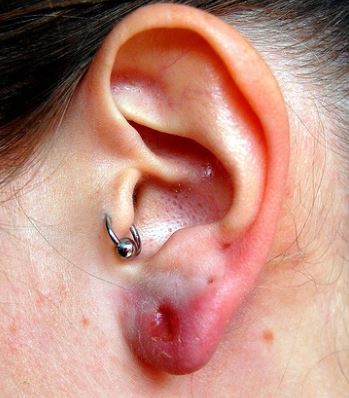These days, more women and men are getting their ears pierced as a popular form of cultural, personal, or artistic expression. One study estimates that almost 50% of women and 20% of men aged 18 to 50 have had piercing in their earlobes. What's important to remember is that skin that has been wounded through piercing is vulnerable to infection. To minimize the risk of an infected ear piercing, always have a trained professional perform the piercing, and keep your newly pierced ears clean.
Signs of Infected Ear Piercing

It's perfectly normal to have some pain and redness at the piercing for about two days. However, any longer than 48 hours might indicate the onset of infection, and you'll need to be aware of symptoms such as:
- Tenderness at or around the piercing, most common with children
- Any persistent swelling, more than two days after piercing
- Excessive bleeding
- Any thick yellowish or greenish opaque discharge (pus) from the piercing, indicating infection
- White or red bump(s) appearing on the earlobes
- Any elevated fever, especially in children
- Placeholder post earring becomes stuck and unable to rotate
- Other less common infected ear piercing symptoms include scaring, nausea, boils, and carbuncles associated with staphylococcus bacteria (Staph infections).
WARNING
If you begin to notice redness and swelling has spread beyond the area of the piercing, and it's accompanied with a mild to moderate fever 48 hours after self-treating for infection, you'll need to contact your local health provider immediately. There may be complications that could lead to permanent damage of your ear.
Why It Happens?
Ear piercing when done by a trained professional, is usually fairly safe. A qualified professional has a good understanding of the anatomy and physiology of the ear to be pierced. Infection is the most common problem, and according to dermatologists, up to 20% of ear piercing results in an infection.
Here is why it happens:
- Piercing the ear with unsterilized equipment
- Using unwashed hands when touching the newly pierced earlobes
- The use of tight earrings, or over-tightening the clasp, resulting in the reduction of blood flow during the healing process
- Irritation and scratching from the earring that further damages the skin around the wound
- Allergic reaction to the metal, especially nickel
How Can You Treat Infected Ear Piercing?
1. Employ Great Care Afterwards
The skin around your ear piercing may be red, tender, and swollen for a couple of days after the piercing, this is normal. Meantime, you will have to take care of the wound to prevent any possibility of infection. However, if you think your piercing might be infected, there are some actions you can take to remedy the problem.
- Wash your hands thoroughly before aftercare treatments.
- Soak your earlobe in a saline solution.
- Gently wash the piercing no more than twice a day with soap and water. Remember to pat dry with a disposable paper towel (cloth harbors bacteria).
- Do not rotate or remove your placeholder earring.
2. Try Antimicrobial Soap
This type of cleanser works by killing nonpathogenic bacteria, and can be purchased over the counter at your local pharmacy. In mild cases of infection, using an antibacterial soap can help eliminate the bacteria that are causing the infection. It is applied in the same manner as regular soap and works best before alcohol and antibiotic treatments.
3. Use Rubbing Alcohol
Using rubbing alcohol is a good way to prevent infections, and it can also be used to treat infected ear piercing if it occurs. To treat the infection, rub the alcohol on either side of earlobes twice in a day. If the piercing isn't infected, and the wound has already healed, apply it on the posts or earrings, after they have been removed, three times a day to help mitigate or prevent infection.
4. Apply Antibiotic Ointment
You can treat an infected piercing using over the counter medications from your local pharmacy. Neosporin is a first-aid ointment available without a prescription that contains three antibiotic ingredients in a petroleum jelly base, and can be used to treat minor skin infections. Antibiotic creams such as Neosporin can be applied after the alcohol treatment and in the same manner.
5. Avoid Using Hydrogen Peroxide
The use of hydrogen peroxide should be avoided because it dries out the piercing site, kills healing cells and encourages a crusting. Over time, the piercing site may become raw and exposed to bacteria that cause infection.
How to Prevent Infection
- Always have your ears pierced by a qualified professional using sterile equipment.
- Make sure the place holding post is hypoallergenic jewelry.
- Apply any antibiotic ointments or creams after you have showered, and before bedtime, daily.
- Remember to loosely clasp the earrings to allow for some swelling.
- People with bleeding disorders, or who suffer from keloid scarring, should avoid piercing altogether.
What's most important for avoiding an infected ear piercing is to not change the earrings for at least six weeks from the date you had them pierced. Changing the earrings before the hole has had time to heal will irritate the wound. Make sure that the piercing shop or parlor you choose uses a good sturdy earring that is hypoallergenic containing no nickel. Although as tempting as it may be for you to try out those cute new earrings you've purchased, it's imperative that you leave the piercing earrings in place until the hole heals.
